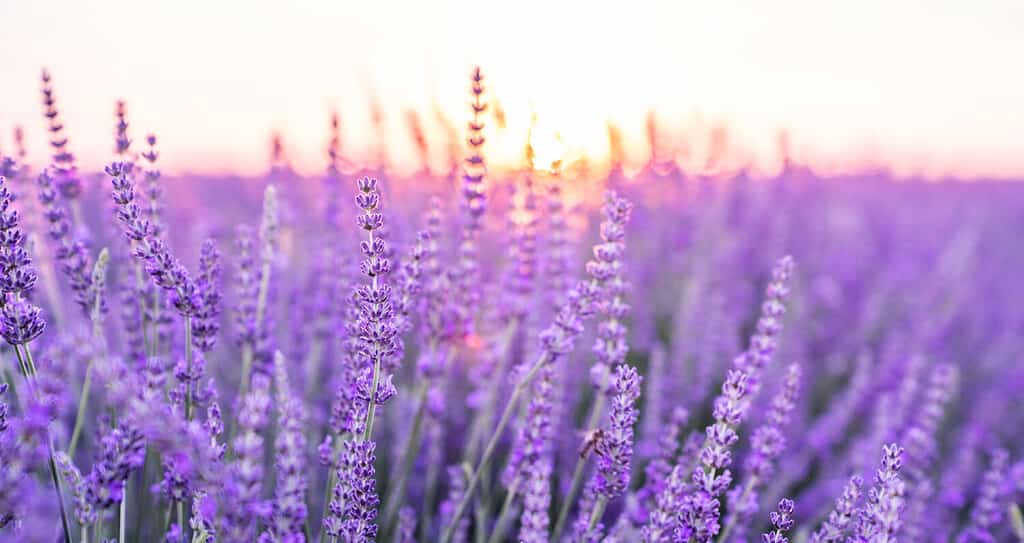Lavender is a treasured flower for its calming scent and stunning color. While this perennial plant can be finicky, with proper planning and care, you can grow your own refreshing crop of this Mediterranean bloom.
In this article, we’ll discuss the best time of year to plant lavender, the lavender growth cycle, and top tips for getting the most out of your harvest.
Let’s dig in!
Lavender 101: What You Need to Know
Lavender is a perennial plant that comes back year after year. However, it’s from the warm, arid Mediterranean region, meaning it needs some extra planning and care in colder areas.
There are two key considerations when deciding which lavender species to plant: your USDA zone or climate and the species of lavender.
There are almost 50 lavender species classified in the Lavandula genus. You can also find hybrids known as lavendin, which is often sold under the lavender name.
If you live in a colder climate, choosing a species of English lavender (Lavandula angustifolia) is your best bet for success. These cold-hardy varieties will survive in USDA zones 5-9 with proper care. You can find bountiful lavender gardens as far north as Nova Scotia, Canada!
If you live in a warmer climate, you can broaden your horizons to include French lavender or Spanish lavender. These varieties do best in USDA zones 8-11.
The Best Time of Year to Plant Lavender
The spring is the best time to plant lavender. Lavender can take anywhere from 10-14 weeks to bloom once planted. The range ultimately depends on the temperature, light exposure, species, and other care factors. If you live in a colder climate, you can start lavender seeds indoors before the last frost.
Planting in mid-spring is optimal for lavender’s natural growth cycle. With this timeline, it will have established roots by the time summer arrives and will bloom in mid to late summer for a lovely late-season harvest. This timeline still allows ample time to prepare the lavender beds for the winter.
Alternatively, you can wait until the risk of frost has passed to plant directly outdoors. This may delay your growing season. Depending on your climate, a delayed growing season may be optimal for heat and sun exposure.

Lavender requires well-drained soil with a pH between 6.7 and 7.3
©ESstock/Shutterstock.com
Can I Plant Lavender in the Summer?
While spring is the best time of year to plant lavender, there are benefits to delaying your efforts until the early summer.
If you live in a Northern area with late-season cold fronts, delaying planting will help avoid surprise frosts and improve sunlight exposure.
Lavender needs at least six hours of full sunlight each day to thrive. Rainy springs could impede your plants’ growth. Furthermore, lavender is sensitive to water-logged soil and susceptible to root rot. Avoiding the rainy season and letting the roots get established could be beneficial.
Planting in the summer also delays the harvest to the fall. This gives you ample opportunity to scatter your gardening efforts if you have several crops on the go.
You can also delay some of your lavender plants to test the proverbial waters and see what works better for your area. This approach will also provide a continual harvest if you want to use lavender for culinary and aromatherapy purposes.
Can I Plant Lavender in the Fall?
There are benefits to planting lavender in the fall. If you live in a warmer climate, you can experience an extended growing season into the winter months. If you live in a colder climate, planting your lavender in the fall will help the root system get established and acclimatize to the cold, improving its resilience and blooming capacity in the spring.
However, taking extra precautions when winterizing your plants is essential if you go this route. Adding mulch to protect the roots will be incredibly helpful during the winter months when establishing new plants.
Can I Plant Lavender Indoors Year-Round?
Lavender also works well as a potted plant. If you decide to plant your lavender indoors, you can grow it whenever you want — even in the middle of the winter.
However, you’ll need to take extra care to ensure your lavender gets enough light, water, and humidity control. Consider investing in a grow light to supplement the sun during the winter months.
If your house is dry during the winter months, your lavender will love it. Be sure not to set your indoor plants near any vents or drafts to prevent shock.
You’ll also need to be vigilant about pest control. The winter typically eradicates pests and protects your plants from invasions during their dormancy. If your plants are indoors, this won’t be the case.

You can plant lavender indoors year-round.
©Kristen Prahl/Shutterstock.com
The photo featured at the top of this post is © iStock.com/Iva Vagnerova
Thank you for reading! Have some feedback for us? Contact the AZ Animals editorial team.







